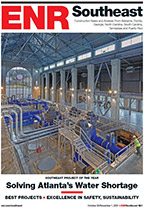
A two-million-gallon water tank in Rochester, N.H., that last month lost half its contents to a steady leak will stay off-line while an accident probe continues, municipal officials say.
Officials are uncertain what caused the Dec. 13 leak. However, based on an initial investigation, city engineer Peter Nourse says the fill pipe for the tank, which was built in 1986, did not appear to be adequately braced.
“It was supposed to have a concrete kicker, but didn’t, leaving a two-inch gap between the bottom of the tank floor and the top of the concrete vault,” Nourse says.
The tank had no concrete restraining elbow fill pipe, which does not comply with the design drawings, Nourse contends. The city plans to contact the tank builder—whose identity is still being confirmed—to resolve questions about the configuration, including why the floor is convex, Nourse says. He says the project engineer was Whitman and Howard, Wellesley, Mass.
The leak prompted an evacuation of hundreds of people because officials feared the tank might collapse or burst.
“One million gallons came out because there was so much pressure at the head of the 70-foot tank,” says Nourse. “Spray coming though a crack in the steel floor ruined the structural integrity of the soil beneath the tank, which drained into the deep ravine below.”
As the tank is used for redundant storage, the city has sufficient water for fire and drinking, Nourse says.
The engineer claims the city’s investigation “has revealed a number of individual conditions and events, which, if aligned, could have caused the failure. The city is consulting with the state Dept. of Environmental Services and Wright-Pierce,” an engineering consultant in Portsmouth, N.H.
Nourse says the investigation will include analysis of the operating parameters of multiple systems, including communication from the water treatment plant to the pump station and from the station to the tank.
“We are not in agreement as to how it happened,” Nourse says. “It is our goal to conclusively determine the cause and implement any modifications required to prevent a future event. We will likely have to do something big to be sure [the tank] won’t roll over or sink down.”
Nourse says a hotel and some homes were within the shadow of the tank. “If something had gone wrong, who knows how catastrophic it could have been,” he says.




